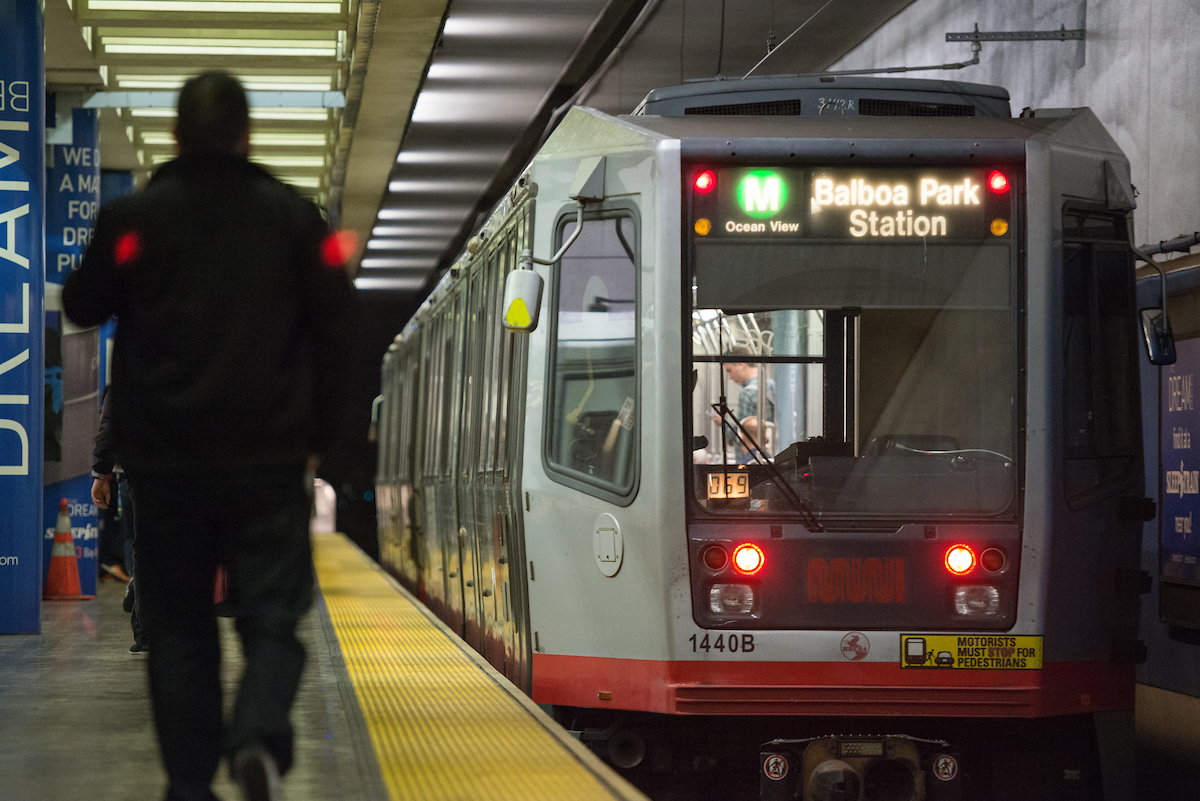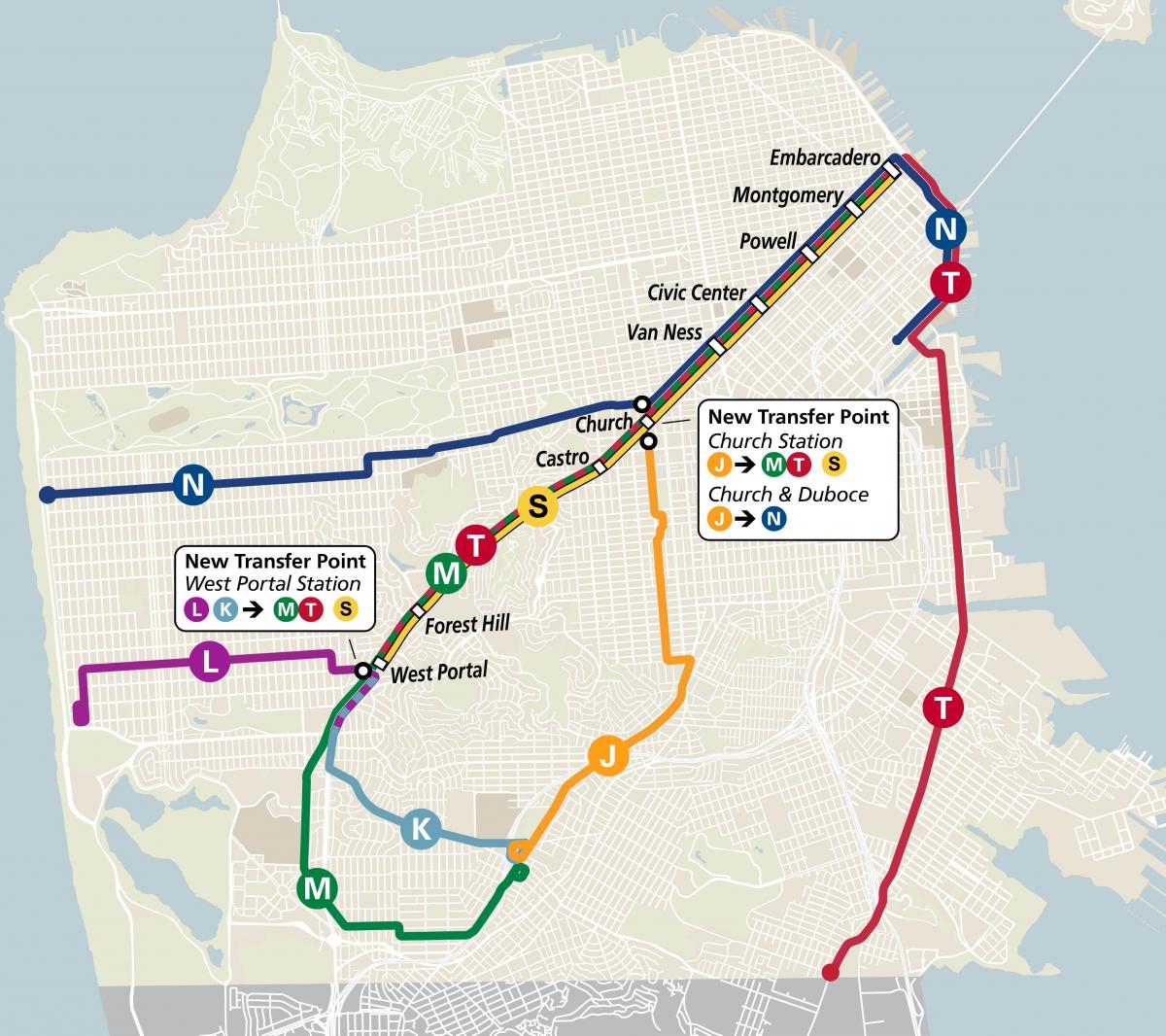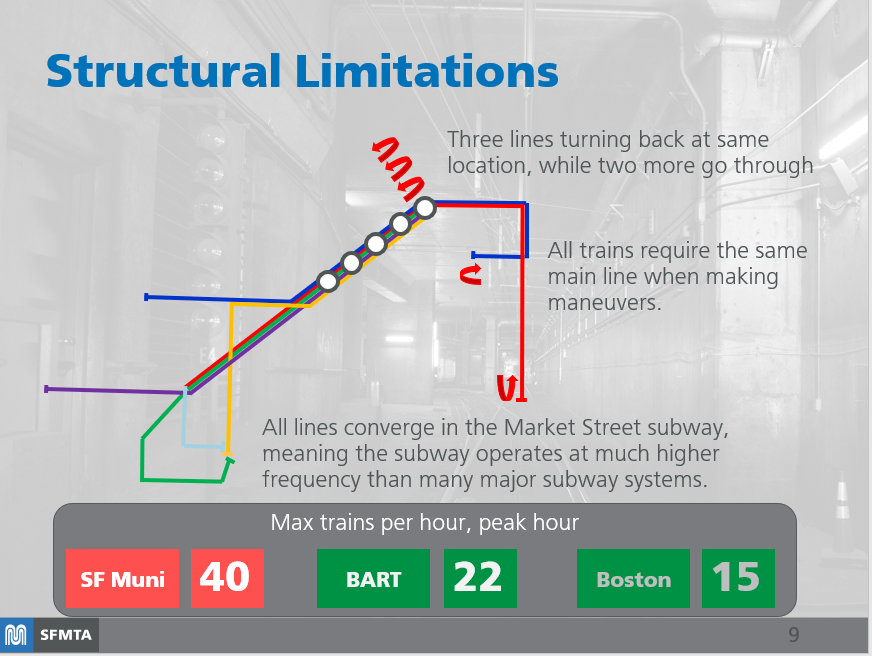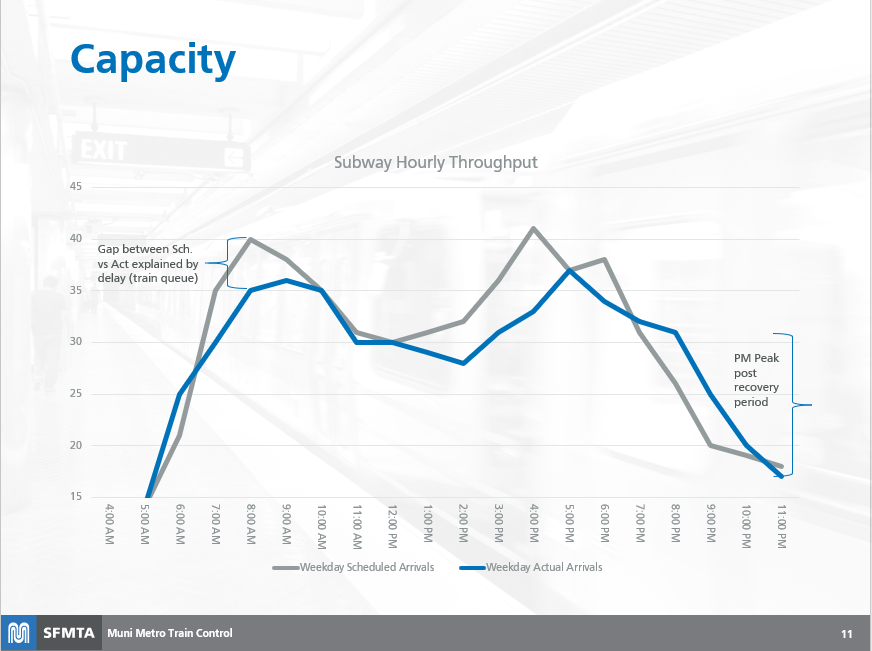By Mariana Maguire

Photo: Muni Metro rail train at a subway platform.
Get ready for a big addition to our COVID-19 Core Service Network: Muni Metro rail is scheduled to return in August to coincide with San Francisco schools welcoming teachers and students back into their classrooms, and more businesses reopening.
But the new Metro rail service will look different when it comes back: Some Muni Metro lines could be taken out of the subway to cut severe pre-COVID-19 delays and backups in the tunnels. This would also allow us to add more cars to our Metro trains to increase capacity.
Putting Metro rail back in service frees up buses currently in use for the L, M, N and T to serve additional routes and improve frequencies systemwide. A high-frequency shuttle in the subway would replace the Metro lines that we take out of the subway. Devoting the tunnels to the higher capacity routes would use the space in our subway much more efficiently. These changes will support more essential trips, physical distancing, and our city’s economic recovery.
Closing the Muni Metro subway in March allowed us to minimize risk to our front-line staff and the community and redirect custodial resources to other facilities. While the rail system was closed to customers, Muni was able to complete critical maintenance work to our vehicles and infrastructure.
All our service changes are possible because of the City’s efforts, the cooperation of our customers, and the steps we have taken as an agency to decrease the risk of transmission of COVID-19. As more of our operators and other staff are gradually able to return to work, we can offer more service.
We’re able to restart Metro rail with the implementation of a mobile cleaning program that allows us to clean buses and trains in the field rather than only at bus and rail yards. This new program helps to expand service levels by keeping more buses on the street. The more vehicles we have in circulation, the easier it is for customers to maintain physical distance onboard.
Highlights of the service changes for rail that are planned for August are below:
Subway Metro Rail:
- All metro buses currently running will be suspended with the return of metro service. This includes the N Bus, L Bus and T Bus. The N Owl and L Owl bus service will continue.
- The N Judah will return with two-car trains.
- More frequent S Shuttles will return between West Portal and Embarcadero stations with two-car trains. These shuttles will run exclusively inside the subway.
- The M Oceanview will return and be combined with the T Third – a practice known as “interlining.” This means we will be able to use two-car trains on both these lines when service returns.
Surface Metro Rail:
Metro rail service will return on the following routes, but will no longer use the subway in order to significantly cut down delays and congestion in the tunnels:
- The L Taraval and K Ingleside will be combined (interlined) and will no longer enter the subway at West Portal Station. This new interlined route will run from the SF Zoo to City College at Balboa Park Station. West Portal will be a transfer point to either the M/T line or S Shuttles for riders who need to continue to downtown.
- The J Church will no longer enter the subway. It will terminate at Market. To continue downtown customers can transfer to the M/T line or S Shuttle at Market and Church, or the N Judah at Duboce and Church.
Here is a map of the new Muni Metro rail configuration:

Making Metro More Reliable
We are all too familiar with the routine backups that occurred in the Metro rail tunnels before COVID-19. Trains would be stuck outside the tunnels, between stations and on the platforms for long periods, often unable to let customers on or off. For years J Church and N Judah customers have experienced delays waiting to enter the tunnel at Duboce. Customers have similar experiences waiting to exit the tunnel at West Portal Station. A major cause is structural – we move all seven of our Muni Metro lines through a single subway tunnel. Like a backed-up freeway, trains get stuck in traffic, causing unacceptable slowdowns and unreliable service across the system.

Graphic: Muni Metro lines converging into a single tunnel.
Change has been needed for a long time, but now, more than ever, we must get people to their jobs and activities reliably and reduce delays that could increase risk of exposure to COVID-19. As we emerge from shelter-in-place, it’s imperative that we take the opportunity to improve our rail service so that we can deliver people to and from school and work reliably. We don’t want our customers stuck on trains in between stations or crowding on station platforms. By limiting the number of lines that go into the subway, we can meet both of those goals.
This will be a big change to our previous Muni Metro rail service and a big adjustment for all of us. Customers would need to adapt some of their commute habits, so we are also working to ensure transfers are convenient for people to easily make their connections, particularly for seniors and people with disabilities.
Addressing Demand for Rail
Our subway system moves our highest volumes of customers, cumulatively, through the core of the city. Reliability is imperative for our customers and operators. Yet over the years as our service has grown, we have placed too much demand on our subway tunnels without improving tunnel capacity.
Before the COVID-19 emergency, we had been running more trains per hour in subway than we can process, roughly 40 trains per hour. Often, however, we’re only able to get 35 of trains through. This makes our service inconsistent and leaves our customers frustrated. To improve reliability and efficiency we need to reduce the number of trains per hour to around 25 to 30 and run higher capacity trains through the subway.

Graphic: Line graphs depicting the disparity between number of trains scheduled to run through the subway and actual number of trains that get from end to end. The difference represents backups and delays that make the current configuration unreliable.
The J Church and K Ingleside lines can only support one-car trains due to surface-level constraints, while the N Judah, M Ocean View, T Third and S Shuttle can accommodate two-car trains. One-car trains take up the same “slot” in the subway as a two-car train. By devoting the tunnels to the higher capacity routes, we could be using the space in our subway much more efficiently. And with ridership volumes, it currently makes the most sense to combine the K Ingleside and L Taraval lines.
The shorter running times means the J Church, K Ingleside, and L Taraval lines will be more frequent along their new surface-only routes. Combined with a more reliable frequent shuttle service, trips downtown will be more dependable and quicker.
We know customers will have questions about these changes. More details on these and other service changes, including detailed maps, will be coming soon.
The modified COVID-19 Core Service Plan supports essential trips that cannot be made in other ways. All San Franciscans are helping us maintain adequate space on Muni for physical distancing by continuing to stay at home except for essential trips. If you need to make an essential trip, please use an alternate form of transportation whenever possible – walking, biking, taxi or driving – to save a seat on Muni for those who don’t have other options.
When you must use Muni for your essential trips, please allow space to physically distance and give yourself extra time. You may need to wait longer for a vehicle with available space. Remember, your trip may now include transfers and a longer walk, and your fare is good for two hours across multiple buses.
We know that for many people with disabilities and seniors, walking farther — or paying for other transportation — isn’t possible. To serve this need, the SFMTA has introduced the Essential Trip Card (ETC) – a discount program to help seniors and people with disabilities make essential trips in taxis during this crisis.
Visit SFMTA.com/COVID-19 for the latest information about Muni routes in service or to explore alternate ways to get around the city.
Published June 19, 2020 at 02:03AM
https://ift.tt/2Yigglz
Comments
Post a Comment